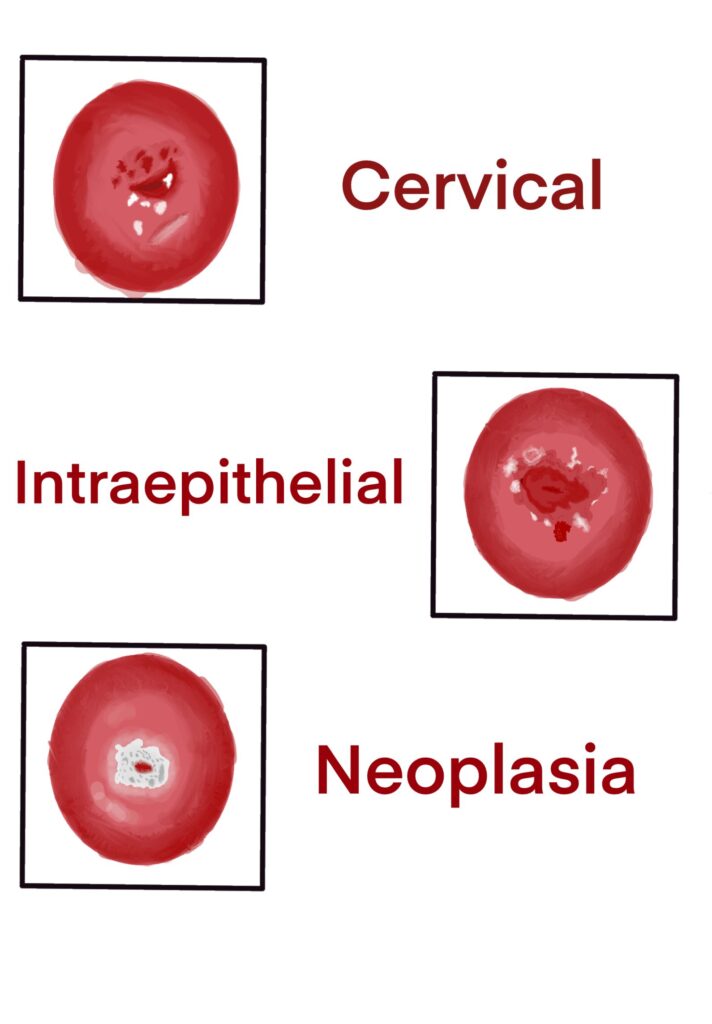
Tristan Dellingner
Don Larson
BIOL_F112X
Apr 21, 2024
Cervical Intraepithelial neoplasia
Cervical intraepithelial neoplasia, commonly referred to as CIN, is the growth of abnormal cells around the cervical area and inside the uterus. The abnormal cell growth can be naturally caused but is most commonly the root of the human papillomavirus (HPV). These abnormal cells can lead to cervical cancer down the line if left untreated and allowed to grow without being monitored. CIN is graded on 3 classes CIN 1, CIN 2, and CIN 3.
Cervical intraepithelial neoplasia is graded based on the severity of the dysplasia. CIN 1 is classified as abnormal cells affecting one third of the thickness of the epithelium. CIN 2 is classified as abnormal cells affecting one third to two thirds of the epithelium. CIN 3 is classified as abnormal cells affecting more than two thirds of the epithelium. The grade of CIN is determined by a pathologist after a colposcopy.
CIN 1 is handled by the body most of the time and requires no intervention. CIN 2 and 3 commonly require colpos or leep procedures. A colposcopy is the biopsy of the cervix and intrauterine tissue. This procedure helps get a more accurate idea of how bad the CIN is. The samples taken from the cervix are sent to pathology. Pathology helps to find out what kind of atypical cells are on the cervix and whether these cells are cancerous or not. A leep is the removal of abnormal cells. This is done using a tool that resembles a potato peeler but also functions as a cauterizer. As the tissue is shaved away on the cervix it is cauterized preventing further growth and aiding in the recovery process. What sections are removed on the cervix are decided by the provider. Often during a colposcopy images of the cervix and the dysplasia present are taken; these images are later used to draw margins of where tissue should be removed on the cervix.
Screening for CIN is done using the pap smear created by Dr George Papanicolaou. Pap smears done under the age of 30 years old are not routinely tested for HPV. They are however tested with reflex which means if abnormal cells are present the lab will then test for HPV. When a person is considered young their body can fight off the HPV most of the time hence why testing is not required till 30. Cervical cancer is rare in younger populations. If tested in younger populations false positives are common and over treating will occur. There is no need for a pap smear under the age of twenty one regardless of sexual activity.
HPV is considered a sexually transmitted infection. In Fact it is almost guaranteed that if you’ve ever had sexual intercourse with someone who has had another partner you have had HPV at some point in your life. It is the most commonly transmitted sexually transmitted disease in the United States. The label STD however creates a lot of stigma. When people learn you have or have a sexually transmitted disease you’re suddenly gross or must be too overactive when it comes to sex. This stigma created a lot of hesitation to be tested for HPV and other infections alike. This created a huge social implication for routine testing as people are not willing to be tested due to fear of the labels they may have placed on them.
Works Cited
Cleveland Clinic. “Cervical Intraepithelial Neoplasia (CIN) | Cleveland Clinic.” Cleveland Clinic, 2011, my.clevelandclinic.org/health/diseases/15678-cervical-intraepithelial-neoplasia-cin. Accessed 21 Apr. 2024.
Last reviewed and updated on 01/31/2022.Feldman, Sarah, et al. “UpToDate.” Www.uptodate.com, 15 Sept. 2022, www.uptodate.com/contents/cervical-cancer-screening-beyond-the-basics/print#:~:text=Cervical%20cancer%20is%20very%20rare. Accessed 21 Apr. 2024.

Tristan’s STEAM Project entailed the growth of abnormal cells within the uterus and cervix, which is known as cervical intraepithelial neoplasia, or CIN. This project was effective in representing the cells found in the cervical area and what actions are to be taken depending on the severity of the abnormal growths. Tristan went into detail explaining the three different classes associated with this condition by interpreting the variation of CIN 1, CIN 2, and CIN 3. He also mentioned when someone might get a colposcopy to further intervene on these abnormal cells, which is a biopsy of the tissues, and explained the process of removing tissue in order to prevent future growth. Lastly, Tristan gave an explanation of the screening process to detect cervical intraepithelial neoplasia. This is done by performing a pap smear, which collects cells in the cervix and undergoes tests to determine. presence of abnormal cells. I enjoyed learning from this representation of cervical intraepithelial neoplasia, and especially like that he included that STDs can create a lot of stigma based on misconceptions. These misconceptions can lead others to believe incorrect information based off judgement and the negative response associated with STDs. As someone that works in healthcare, I believe in educating patients to the fullest as a way to promote restoration of their health. I personally learned a lot that I didn’t know by reading the information provided and think that others can benefit from it as well. I hope to become a nurse one day and enjoy learning from others based on their own knowledge and experience. Overall this project was interesting to gain a new understanding of!